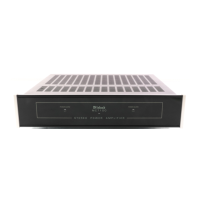DESIGN PHILOSOPHY
The MC7100 stereo power amplifier is designed to operate loudspeakers with a nominal
impedance of 4 to 8 ohms. It features a new circuit design that keeps distortion levels so
low it takes special test gear for accurate measurements.
The design philosophy that resulted in the outstanding performance of this amplifier in-
volved several different techniques. Every stage of voltage or current amplification was design-
ed to be as linear as possible prior to the use of negative feedback,
1. Each transistor is selected to have nearly constant current gain (Beta) over its entire
operating range.
2. The load impedance presented to each amplification stage is made as uniform as possi-
ble for all signal levels.
3. The input impedance of each amplifier stage is increased and made more linear by us-
ing emitter degeneration whenever possible.
4. Resistors and capacitors in the signal path are carefully selected to have exceedingly
low voltage coefficients (change of resistance or reaction with applied voltage). Precision
metal film resistors and low dielectric absorption film capacitors are used in all critical cir-
cuit locations.
5. Output transistors have matched uniform current gain, high current gain-bandwidth pro-
duct, low output capacitance and large active-region safe operating area. These characteristics
together with the automatic tracking bias system eliminate crossover distortion.
PROTECTION CIRCUITS
Some manufacturers of power amplifiers claim that their products do not need or use pro-
tection circuits and that such circuits compromise performance. Mclntosh feels that protec-
tion circuits are desirable and necessary to prevent amplifier or loudspeaker damage due
to abnormal circumstances. The genius of Mclntosh engineering has resulted in protection
circuits which have no effect or compromise on the normal performance of a power amplifier.
The SENTRY MONITOR circuit is a good example. The MC7100 incorporates seven specific
protection circuits to enhance its performance, increase its reliability and protect loudspeakers.
SENTRY MONITOR CIRCUIT
All power transistors have limits for the maximum amount of power they can handle. The
MC7100 output transistors and power supply have been designed to allow very high current
flow into properly matched load impedances. However, if a short circuit or very low load im-
pedance is connected to the MC7100 outputs, destructive current levels could be reached
if it was not controlled by the SENTRY MONITOR circuit. This circuit senses the dynamic
operating time, voltage and current of the output stage, and controls it to safe operating limits.
The SENTRY MONITOR circuit does not limit the power output available from the amplifier.
THERMAL CONTROL
All power transistors have limits to the maximum amount of heat they can safely tolerate.
The MC7100 uses a highly efficient amplifying circuit which produces relatively little heat
for the output power produced. The amplifier uses large area heat sinks to efficiently dissipate
what heat it does generate. Natural convection air flow is sufficient for safe cool operation.
If the cooling air is blocked, or the amplifier operating temperature is forced too high, ther-
mal cutout switches will turn off the speakers. Both POWER GUARD indicators will light con-
tinuously to show that thermal protection is operating. When the problem is corrected and
13
TECHNICAL
DESCRIPTION

